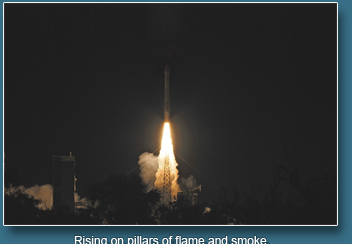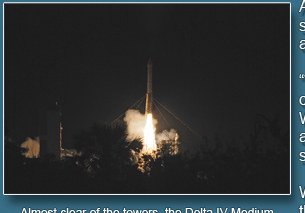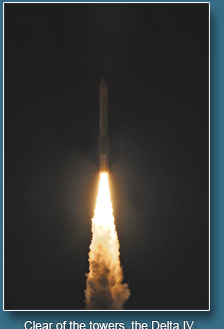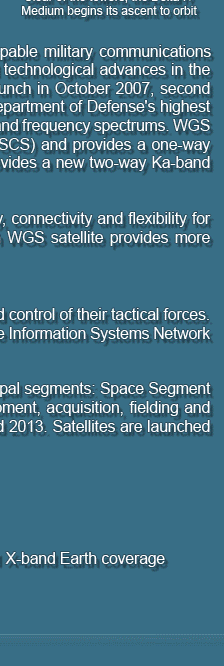WGS-4.
United Launch Alliance Delta IV Rocket Successfully Launches U.S. Air Force�s
Wideband Global SATCOM-4 (WGS-4) Satellite Cape Canaveral Air Force Station,
Fla., (Jan. 19, 2012) A United Launch Alliance Delta IV rocket carrying the
Wideband Global SATCOM-4 (WGS-4) satellite for the United States Air Force
lifted off from Space Launch Complex-37 here at 7:38 p.m. EST today. This is
ULA�s first launch of the year and marked the 18th launch of the Delta IV
vehicle. �We are honored to have worked closely with our Air Force and mission
partners to enable today�s successful launch of the WGS-4 satellite. WGS-4 will
provide important capabilities to the soldiers, sailors, airmen and marines
protecting our freedoms around the world,� said Jim Sponnick, ULA vice
president, Mission Operations. �This mission begins the most aggressive launch
campaign in the history of the EELV program, with nine national security and two
NASA launches scheduled this year.� This mission was launched aboard a Delta IV
Medium-plus configuration vehicle using a ULA single common booster core powered
by a Pratt & Whitney Rocketdyne RS-68 main engine, along with four Alliant
Techsystems GEM 60 solid rocket motors. The five-meter diameter upper stage was
powered by a PWR RL10B-2 engine with the satellite encapsulated in a five-meter
diameter composite payload fairing. �WGS was the first of the new constellation
of satellites to integrate and launch on both the Delta IV and Atlas V vehicles
-- the first two on Atlas and now, with WGS-4, the second one on our Delta IV
launch system,� said Sponnick. �Our ability to integrate and launch satellites
successfully and efficiently on two launch systems to provide operational
flexibility was a primary reason that ULA was formed.� Wideband
Global SATCOM provides anytime, anywhere communication for the warfighter
through broadcast, multicast, and point to point connections. WGS is the only
military satellite communications system that can support simultaneous X and Ka
band communications. Mission WGS provides flexible, high-capacity communications
for the Nation's warfighters through real world operationalization of the WGS
system and the associated control systems. WGS supports the defense
communications system; the Army's ground mobile forces, the Air Force's airborne
terminals, Navy ships at sea, the White House Communications Agency, the State
Department, and special users. WGS provides an order of magnitude increase in
military communications increased bandwidth, providing high data rate and long
haul communications for marines, soldiers, sailors and airmen worldwide.
Features The WGS system is a constellation of highly capable military
communications satellites that leverage commercial methods and technological
advances in the communications satellite industry. With its first launch in
October 2007, second launch in April 2009 and third launch in December 2009, WGS
Space Vehicles (SV) -1,-2 and -3 are the Department of Defense's highest
capacity communications satellites. A constellation of six satellites will
provide service in both the X and Ka-band frequency spectrums. WGS supplements
X-band communications now provided by the Defense Satellite Communications
System (DSCS) and provides a one-way Ka-band service, similar to what the Global
Broadcast Service (GBS) provides. Additionally, WGS also provides a new two-way
Ka-band service. These digitally channelized and transponded satellites provide
a quantum leap in communications capacity, connectivity and flexibility for U.S.
military forces while seamlessly integrating with current and future X- and
Ka-band terminals. Each WGS satellite provides more SATCOM capacity than the
entire DSCS constellation. Background WGS provides essential communications
services, allowing Combatant Commanders to exert command and control of their
tactical forces. Tactical forces will rely on WGS to provide high-capacity
connectivity into the terrestrial portion of the Defense Information Systems
Network (DISN). Part of MILSATCOM Directorate's Wideband SATCOM Group, the WGS
system is composed of three principal segments: Space Segment (satellites),
Control Segment (operators) and Terminal Segment (users). MCSW is responsible
for development, acquisition, fielding and sustainment of the WGS Program. Block
II satellites 4, 5 and 6 are anticipated for launch in 2011, 2012 and 2013.
Satellites are launched via the Delta IV or Atlas V Evolved Expendable Launch
Vehicle (EELV). General Characteristics Primary Function: High-capacity military
communications satellite Primary Contractor: Boeing Satellite Development Center
Payload: Transponded, cross-banded-X and Ka-band communications suite Antennas:
8 beam, transmit and receive X-band Phased arrays and 10 Ka-band Gimbaled Dish
Antennas, 1 X-band Earth coverage Capability: 39 125-MHz Channels via digital
channelizer/router, 2.1 Gbps capacity











